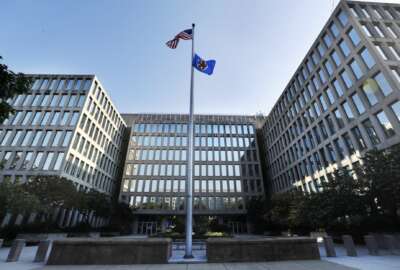

The Trump administration has sent lawmakers its legislative proposal to merge the Office of Personnel Management with the General Services Administration.
The Trump administration — via the Office of Management and Budget — has officially sent lawmakers a long-awaited proposal that would eliminate the Office of Personnel Management as an independent entity.
The legislative proposal, which Federal News Network obtained shortly after it was sent to Capitol Hill on Thursday, suggests merging most of OPM’s functions into the General Services Administration. The Administrative Services Merger Act of 2019, as the proposal is titled, would authorize the transfer of OPM’s information technology, its fee-for-service HR Solutions, retirement and health and insurance services to GSA.
“GSA will create a new personnel service to house the human resources and employee lifecycle management shared service offerings,” Russell Vought, OMB’s acting director, wrote in a May 16 letter to House and Senate leadership. “Agencies will benefit from GSA helping them to obtain more strategic and comprehensive support for their needs.”
Vought’s letter, which was also sent to the chairmen and ranking members of the appropriations, budget and oversight committees, describes in more detail how the administration expects to merge OPM with GSA.
It’s also the first time the Trump administration has explicitly stated what OPM functions it believes it needs legislative authority to transfer.
Specifically, the proposal recommends a transfer of the OPM director’s vast array of existing legal authorities to the GSA administrator.
“Except as otherwise specified in this act, all functions and authorities vested by statute, presidential delegation or assignment, or other law in the Office of Personnel Management or in the Director of the Office of Personnel Management, as well as all resources of the Office of Personnel Management, are hereby transferred to the Administrator of General Services,” the proposal reads.
The legislation would transfer OPM’s discretionary budget authority, as well as the agency’s revolving fund and trust funds to GSA.
All functions, powers and authorities that were once the responsibility of the OPM director would now be the responsibility of the GSA administrator, according to the proposal. The OPM director would lead a new national service within GSA. It would be on-par with GSA’s Federal Acquisition Service and its Public Buildings Service, and would handle federal employee health, retirement and insurance, as well as other human resources and employee lifecycle management shared services solutions.
“This transfer will make it easier for federal agencies to locate and access the human capital management solutions and contracts they need,” the proposal reads. “This transfer also enables agencies to obtain more strategic and comprehensive support for their needs. Agencies that today rely on GSA to help them procure human capital management solutions will tomorrow have access to a much more comprehensive solution set, including consulting support to help them think through human capital strategies before making a purchase.”
Rulemaking and delegating authority for the OPM director, however, would go to OMB to allow a new federal workforce office to “assume a significant policy leadership role,” the proposal reads.
The legislative proposal officially establishes the Office of Federal Workforce Policy within OMB. A presidentially-appointed administrator would lead this new office, which would be in charge of:
The federal workforce policy administrator would report to OMB’s deputy director for management and would “provide overall direction for and leadership of workforce policy” of agencies in the executive branch, according to the proposal.
In describing the Trump administration’s plans for the OPM reorg, Margaret Weichert, OMB’s deputy director for management and acting OPM director, has described this new federal workforce policy office as one that would be modeled after the Office of Federal Procurement Policy.
Weichert has said the administration envisioned building out OMB’s existing Office of Performance and Personnel Management as the foundation for this new federal workforce policy organization. The President’s 2020 budget proposal requested $400,000 for this office and budgeted an additional three employees, which Weichert has said would be starting point.
In making the case for the OPM reorganization, the Trump administration offered up a few more details about its plans earlier this week. But the legislative proposal offers the most clear picture to date of a variety of shifting roles and responsibilities.
According to the legislative proposal, the OPM director position itself would still exist as a leadership role within GSA, but it would lose some of its existing authorities and responsibilities. The OPM director, for example, would no longer chair the Chief Human Capital Officers Council. That responsibility would instead go OMB’s deputy director for management. The GSA administrator would also serve as a CHCO Council co-chair.
The legislative proposal also broadens the responsibilities for the GSA administrator. The head of GSA would be tasked with leading “governmentwide efforts to build and sustain a federal workforce that consistently excels at achieving agency missions,” the proposal reads.
The proposal explicitly tasks the GSA administrator with crafting a forward-looking vision and strategy for an evolving federal workforce, which Weichert, in making the case for the OPM reorganization to reporters this week, said OPM wasn’t structurally or strategically positioned to do.
The GSA administrator would also have additional responsibilities to work with agencies and the CHCO Council to develop workforce policies and regulations.
In addition, the legislation would restructure the pay scale for the GSA administrator and OPM director. It also establishes the deputy GSA administrator as a presidentially-appointed, Senate-confirmed position. Other sections of the legislation eliminate OPM’s requirements under the Chief Financial Officers Act and add federal workforce policy development as an activity under OMB.
The legislation also proposes merging OPM’s inspector general functions and resources into GSA OIG.
The proposal comes to members days before the House Oversight and Reform Government Operations Subcommittee is expected to scrutinize the administration’s planned OPM reorg. The hearing is titled, “Trump’s War on Merit-Based Civil Service.”
The subcommittee’s chairman, Rep. Gerry Connolly (D-Va.), has publicly expressed frustration the administration hasn’t offered more detail to date on its reorganization proposal.
But the Trump administration needs legislative buy-in not only to authorize the transfer but also to appropriate funding to make it happen.
The President’s 2020 budget proposal requested $50 million for the OPM-GSA merger. The administration this week shared its “case for change” with Congress and the media. Weichert said the reorg could save anywhere from $11-to-37 million a year in contracts and facilities consolidation.
The administration this week confirmed OPM will face a $70 million funding shortfall when the National Background Investigations Bureau and its security clearance business moves to the Pentagon on Oct. 1.
Copyright © 2025 Federal News Network. All rights reserved. This website is not intended for users located within the European Economic Area.
Nicole Ogrysko is a reporter for Federal News Network focusing on the federal workforce and federal pay and benefits.
Follow @nogryskoWFED


